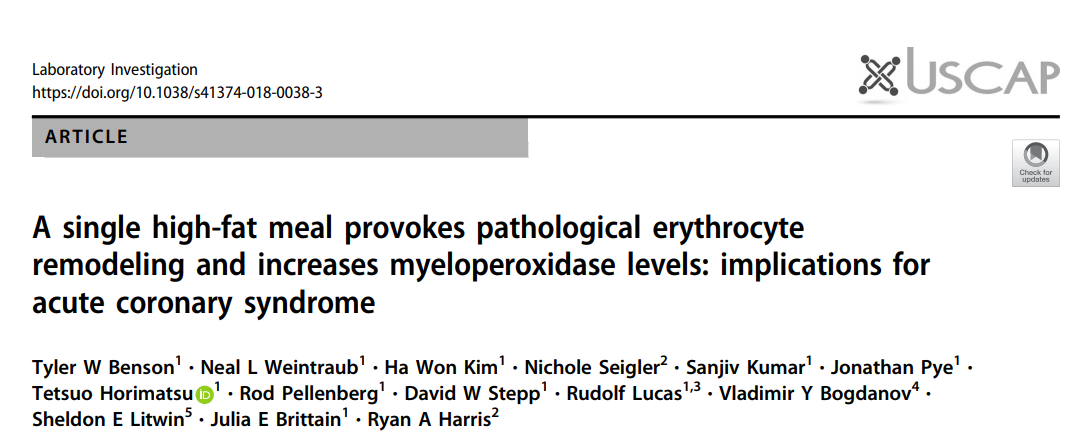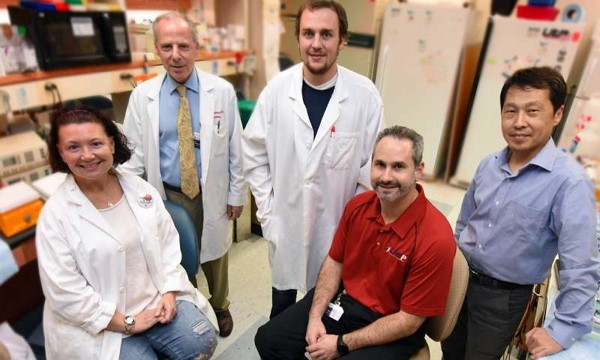Introduction: A high-fat diet was once considered one of the risks of cardiovascular disease, but scientists do not know the underlying mechanism. Now, the latest research from the University of Augusta Georgia Medical School (MCG) reveals the link between high-fat foods and cardiovascular disease. The study found that even eating a high-fat diet quickly “redraws” red blood cells to make them sharper, smaller, and increases vascular pressure, thereby raising the probability of cardiovascular disease.

The paper was published online in the March 23 issue of the Nature Journal, a journal of the Journal of Laboratory Investigation, entitled "A single high-fat meal provokes pathological erythrocyte remodeling and increases myeloperoxidase levels: implications for acute coronary syndrome."
Scientists from the University of Augusta Medical School (MCG) of the University of Augusta, USA, recruited 10 healthy young men to conduct relevant trials to verify the association of high-fat diet with red blood cells and vascular dysfunction.
They used fat milk, cream, and ice cream to make a high-fat milkshake (similar in fat and calorie content to some fast foods) and confirmed that high-fat milkshakes quickly “remodel” the blood system after drinking for 1 hour. - Including changes in the shape of red blood cells, increased triglycerides, cholesterol and free fatty acid concentrations, and up-regulation of heme proteinase levels. These changes increase vascular pressure and trigger an immune response similar to that of an infection.
Although this dramatic, unhealthy change is only temporary, a high-fat diet can cause a certain degree of damage accumulation. Neal L. Weintraub, a well-known American cardiologist and deputy director of the MCG Vascular Biology Center, hopes that this study will provide a certain prompting function so that everyone can avoid a long-term, high-fat diet. "If this fat content is high, then we need to be cautious about the next meal, the next meal choice," he explained.

A series of "bad" influences
Red blood cells are the most abundant type of blood cells in the blood. They are also responsible for the transport of oxygen while being flexible in the body. A healthy red blood cell carries a negative charge that keeps it away from other cells and is therefore more conducive to flow. Recent research shows that eating a high-fat diet can make this important cell become narrow, forming spine cells and secreting harmful substances.
In addition to red blood cells, a high-fat diet also increases the concentration of peroxidase (MPO) in the blood. MPO is a hemopexin-containing heme protease secreted by neutrophils, monocytes, and macrophages of certain tissues, with impaired vasodilation, high-density lipoprotein cholesterol oxidation, atherosclerosis, Oxidative stress, myocardial infarction related. MPO causes endothelial cell damage, promotes the formation and instability of arterial plaque, and affects the skeleton of red blood cells, rendering them unable to function and maintain elasticity. "The level of peroxidase in the blood is directly related to the risk of heart disease." Neal L. Weintraub believes this is a very important discovery.
At the same time, monocytes will also change. As an important white blood cell, monocytes are an important part of the body's defense system and are responsible for handling excess fat and wounded, aging blood cells. However, a high-fat diet can promote leukocyte-induced inflammation and increase blood lipid levels.
When the Neal L. Weintraub team used flow cytometry to detect red blood cells, they found that the level of reactive oxygen species in the cells increased. This change will cause a permanent change in the function of the protein. Researchers believe that the effect of a high-fat diet on red blood cells is similar to the interference of huge ice cubes in rivers—physical changes affect the normal blood circulation.
Change is temporary
The good news is that these changes are only temporary, avoiding long-term, continuous high-fat diets. At least a mouse model and a few clinical trials have shown that these bad changes can return to normal and take about 8 hours.
It is worth noting that when high-fat diets are fed for a long period of time, they will cause permanent changes in the blood cells of the mice, thereby increasing the risk of cardiovascular disease. This is also of warning significance to humans.

(from left) Dr. Julia E. Brittain, Dr. Neal L. Weintraub, Tyler W. Benson, Dr. Ryan A. Harris and Dr. Ha Won Kim photo taken in the Medical College of Georgia's Vascular Biology Center Lab. Credit: Phil Jones, Senior Photographer, Augusta University
Primary prevention
Although changes in the shape and size of red blood cells will affect blood vessel health, this still needs more research to confirm. However, Neal L. Weintraub believes that primary prevention is an important point in maintaining the health of the cardiovascular system, including healthy diet, regular exercise and close attention to cholesterol, blood pressure and other indicators. Even those with a high genetic risk for cardiovascular disease can significantly reduce the probability of the disease through these positive changes.
In the study, they discovered that by performing an aerobic exercise on the subject, this method can reduce the time for blood to return to normal (4 hours) and increase the ability of blood vessels to expand.
Reference:
Just one high-fat meal sets the perfect stage for heart disease
Souce: NovoPro 2018-04-03
